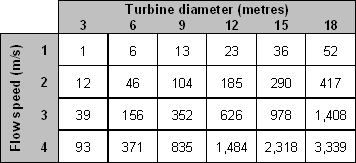Energy Production Costs
Oceanflow has detailed models for determining turbine performance, annual energy output and the unit cost of generation in different flow regimes.
What power is available?
Water is over 800 times more dense than air so the power in flowing water that can be converted to electricity with Evopod's turbine is considerably greater that with an equivalent diameter wind turbine. If you know the water flow speed then the table below can give you an idea of the electricity that can be generated (in Kilowatts) from a single turbine.

Typical power output (kW)
Annual energy
The energy that can be recovered from a tidal stream is influenced by the tidal flow variations over the lunar day and the synodic month (moon and sun alignments). The energy that can be recovered from rivers will change with the seasons (rainfall / ice melt) while the flow from ocean currents is less strong but can be very consistent.
Cost of generation
Oceanflow has CAPEX and OPEX model to determine the NPV of the cost of generation taking into account detailed cost make-up covering all aspects of a project including planning, permitting, build, deployment, grid tie-back and operation and maintenance.
Evopod offers attractive costs of electricity generation with early stage developments because of:
- the ability to operate in the more energetic deep water tidal stream areas
- the adoption of a high efficiency large diameter turbine driving proven generating packages
- the relatively low cost of installation compared to fixed seabed mounted solutions
- the high up-time through the ability to swap out units from their moorings / grid connection for periodic maintenance
< back